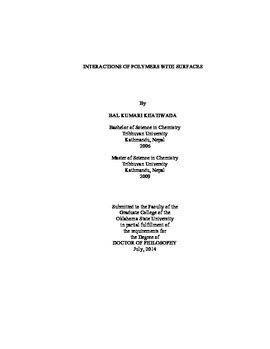| dc.contributor.advisor | Blum, Frank D. | |
| dc.contributor.author | Khatiwada, Bal Kumari | |
| dc.date.accessioned | 2016-09-29T18:29:35Z | |
| dc.date.available | 2016-09-29T18:29:35Z | |
| dc.date.issued | 2014-07 | |
| dc.identifier.uri | https://hdl.handle.net/11244/45120 | |
| dc.description.abstract | The glass transition behavior of poly(methyl methacrylate) (PMMA) adsorbed on silica (surface area = 200 m2/g) was studied by temperature modulated differential scanning calorimetry (TMDSC). For small amounts of the polymer adsorbed on silica (1-2 mg of polymer/m2 of silica), the glass transition temperature (Tg) of the polymer was significantly increased compared to that of the bulk polymer. The polymer with a higher Tg has been called tightly-bound polymer. Addition of more polymer on the surface resulted in the composites with some polymer that had glass transitions similar to that of the bulk polymer, and has been called loosely-bound polymer. TMDSC heat flow curves were used to estimate the amount of tightly-bound polymer using a bound-segment model, a model based on the polymers divided into loosely and tightly-bound polymers. | |
| dc.description.abstract | Heat capacities of the bulk PMMA, silica, and PMMA/silica composites were measured by quasi-isothermal heat capacity measurements. The heat capacities of the composites were significantly smaller than the ones predicted by a simple mixture model, where the heat capacities of the composites are additive based on the two components. Two-state, exponential, and transitional models have been used to fit the heat capacity of the polymer adsorbed on silica surface. | |
| dc.description.abstract | Deuterium (2H) solid-state NMR and differential scanning calorimetry (DSC) were used to probe the interfacial interactions of poly(vinyl acetate) (PVAc-d3) incorporated into graphene oxide (GO) surfaces. The glass transition behavior of the bulk and PVAc-d3/GO composites was determined by temperature modulated DSC. Incorporation of the PVAc-d3 into the GO significantly reduced the intensity of the glass transition. In fact, the glass transitions of the composites almost disappeared (very weak and broad glass transition) when the composition of the polymer was 50 % or less (w/w). 2H NMR measurements were carried out to understand the dynamics of the polymer segments incorporated with the GO. In contrast to the behavior for the bulk polymer, the polymer segments incorporated with GO showed heterogeneous mobility. The Pake powder patterns of PVAc-d3/GO samples had peaks from polymer segments that were more mobile and less mobile than the bulk polymer. | |
| dc.format | application/pdf | |
| dc.language | en_US | |
| dc.rights | Copyright is held by the author who has granted the Oklahoma State University Library the non-exclusive right to share this material in its institutional repository. Contact Digital Library Services at lib-dls@okstate.edu or 405-744-9161 for the permission policy on the use, reproduction or distribution of this material. | |
| dc.title | Interactions of polymers with surfaces | |
| dc.contributor.committeeMember | Nelson, Toby L. | |
| dc.contributor.committeeMember | White, Jeffery L. | |
| dc.contributor.committeeMember | Ausman, Kevin Douglas | |
| dc.contributor.committeeMember | Zhou, Donghua H. | |
| osu.filename | Khatiwada_okstate_0664D_13530.pdf | |
| osu.accesstype | Open Access | |
| dc.type.genre | Dissertation | |
| dc.type.material | Text | |
| thesis.degree.discipline | Polymer Chemistry | |
| thesis.degree.grantor | Oklahoma State University | |
